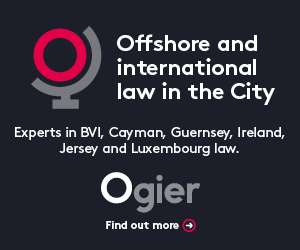
Securitisation and Cayman Orphan SPVs – Part One
In the first in a series of three articles, Paul Trewartha and Simon Lawrenson, Partners at Mourant Hong Kong, examine the key features of a securitisation vehicle and the advantages of utilising an Orphan SPV in the Cayman Islands for a securitisation transaction.
What is securitisation?
Securitisation combines a series of tools and processes in order to turn regular illiquid receivable assets of a company into liquid securities which are backed by the relevant receivable assets and which can be easily issued and, if necessary, transferred in the secondary market.
Under a traditional securitisation transaction, investors (the Noteholders) will purchase secured, limited recourse notes (the Notes) which are issued by an ‘orphan’ special purpose vehicle (the Orphan SPV) in the capital markets to enable the Noteholders to take a position in, or obtain exposure to, specific underlying receivable assets (the Underlying Assets) which are pooled together and back such Notes. The Noteholders take such a position without the risks or balance sheet consequences of directly holding the Underlying Assets. This is achieved by isolating the credit risk of the Underlying Assets from the credit risk of the Orphan SPV and using the cashflow from the Underlying Assets to fund the payments required on such Notes (and in effect, securitising the Underlying Assets into the Notes issued by the Orphan SPV). The proceeds of the issuance of the Notes will typically be used by the Orphan SPV to acquire the Underlying Assets. In consideration, the Orphan SPV will immediately grant security over the Underlying Assets in favour of the trustee of the Notes (the Trustee) who will hold the security for the benefit of the investors or Noteholders.
The Underlying Assets will typically include a single class of assets such as residential mortgage loans, commercial mortgage loans, auto car loans, credit card receivables, insurance premium loans or other types of receivables.
Investors in the capital markets will typically include investment funds, treasury departments of banks, insurance companies and pension funds.
Benefits of securitisation – Cayman Islands
There are many reasons why securitisation will benefit parties to the transaction and the economy overall, however parties will typically enter into a securitisation for one or more of the following reasons:
- to obtain a diversity of funding for arrangers or diversification of risk profiles for investors;
- to achieve lower cost of funding than other forms of capital raising;
- to obtain a higher credit rating than other forms of capital raising;
- to achieve balance sheet relief and the monetisation of an originator’s Underlying Assets;
- to transfer the credit risk of the Underlying Assets from the originator or arranger to the capital
- markets; and
- to create various tranches of Notes with varying maturity, return and seniority from a single class of Underlying Assets.
Diversity of funding and lower funding costs
Securitisation allows banks and financial institutions to diversify their funding mix ensuring they are not dependent on only a single or limited sources of funding which can increase the risk-profile of a financial institution when markets are turbulent. A diversified funding mix provides greater assurance of access to funds and an ability to access funds at an overall lower cost of funding. Furthermore, from a bank’s perspective, the bank can reduce any potential maturity mismatches against, for example, shorter term deposits by obtaining funding with the same tenor that it lends (such as in the case of residential mortgages). Furthermore, in markets where interest rates are increasing, such as the current environment, securitisation provides an avenue to raise funds at a lower interest rate which feeds into the ability to access funds at an overall lower cost.
Higher credit rating
Securitisation can be an attractive form of capital raising for sponsors and arrangers compared to a straight debt issuance or loan facility. If an arranger has already issued significant debt instruments in the capital markets with a poor credit rating, then it may not be able to obtain a good or sufficient credit rating on a further straight debt issuance. However, if that arranger has a lot of receivable assets on its books, then it can pool these assets (and their cashflows) to support a securitisation issuance and package them with certain credit enhancements to issue an instrument bearing a high credit rating.
Tranching
An important feature of a securitisation is the ability to issue securities backed by the same pool of Underlying Assets (such as a pool of residential mortgage loans) which have different risk and return profiles, a mechanism known as ‘tranching’. Accordingly, an Orphan SPV issuer in a securitisation will typically issue different tranches of Notes against the same pool of assets, for example, Class A Notes, Class B Notes and Class C Notes. These Notes would all bear different terms largely revolving around the maturity date, yield and credit rating.
Tranching and allocation of losses
In the case where an Orphan SPV issues different tranches of Notes in a securitisation, the terms of the transaction documents will provide for a waterfall of payments such that as the pool of Underlying Assets are repaid and the funds are collected on behalf of the Orphan SPV, those funds would be allocated to, for example, the redemption of the Class A Notes first and only upon their full redemption would payments be then made to redeem the Class B Notes (and the same process would repeat with respect to the Class C Notes). Accordingly, the Class A Notes would typically have a higher credit rating, but a lower yield, than the Class B Notes which in turn would have a higher credit rating, and a lower yield, than the Class C Notes. The priority provided under the waterfall to the Class A Notes and the Class B Notes has the effect of ensuring that any losses affecting the Underlying Assets would be first borne by the Class C Notes. For example, to the extent that the Class C Notes represent 10% of the overall Notes issued by the Orphan SPV, then the senior notes would not suffer any losses until the default on the pool of Underlying Assets exceeds 10%. Likewise, if Class B Notes represent 30% of the Notes issued, then the Class A Notes would be protected until the defaults experienced on the pool of Underlying Assets exceeds 40%.
This tranching process enables the Orphan SPV to issue Notes with different risk and return profiles in respect of the same pool of assets (assuming the Underling Assets are of a sufficient credit quality across the entire profile of the relevant pool of assets) making the securities more attractive to a broader range of investors.
Cayman Islands Orphan SPV – Key features and advantages
Incorporation and management
Incorporation of a Cayman Islands exempted company as an Orphan SPV does not require any government approval and can be completed in a short period of time (incorporation within one business day is possible). The minimum number of directors required under the Companies Act (as amended) of the Cayman Islands (the Companies Act) is one. There are no residency requirements for directors or officers and corporate directors are allowed. There is no minimum authorized or issued share capital required for an exempted company under the Companies Act. For more information on a Cayman Islands exempted company, please see our guide ‘Cayman Islands exempted companies’.
Accounting treatment
One of the primary features of a securitisation transaction, and a key driver from an arranger’s perspective (particularly in the Asian market) in establishing a securitisation vehicle, is the off-balance sheet advantages in respect of the Underlying Assets. An arranger would want to ensure that the Orphan SPV is not a subsidiary or affiliate of the arranger or originator (or their respective corporate group, to the extent the arranger and originator are different entities), but an entity that is incorporated as an independent company to achieve an ‘orphan SPV’ status. The off-balance sheet advantages are attractive to an arranger and include, amongst other things:
- the arranger can take comfort that the Underlying Assets pooled for the purpose of the securitisation issuance will not, in the event of an insolvency, be sheeted back or consolidated with the arranger or the arranger group, providing benefits to the arranger from a legal, accounting and regulatory perspective, and
- the sale of the Underlying Assets by the arranger (if originated by the arranger) to the Orphan SPV and subsequent removal of them from its balance sheet frees up capital reserves it may be required to hold against such assets to improve capital adequacy ratios in addition to providing cash-receipts on the sale of such assets.
Setting up a Cayman Islands Orphan SPV through trusts
Establishing an SPV as an ‘orphan’ is permitted in the Cayman Islands and can be done by a corporate services provider such as Mourant Governance Services (Cayman) Limited. An Orphan SPV, in the Asian context, can typically be established by setting up one of the following trusts:
Charitable trust
Shares in the Orphan SPV will be issued to a licensed trustee which:
- is established in the Cayman Islands and which is completely independent from the arranger;
- will hold the legal title to the shares in the Orphan SPV; and
- will establish a charitable trust structure by declaring a trust over the shares issued by the Orphan SPV such that the beneficiary will be a charitable organisation in the Cayman Islands.
This arrangement will make the SPV ‘orphan’ in nature given that the shares of the Orphan SPV form part of the trust assets of the charitable trust and are not owned by the arranger or other originator of the Underlying Assets.
STAR trust (purpose trust)
Similar to a charitable trust, the shares in the Orphan SPV will be issued to a licensed corporate trustee, however the purpose trust (known as a STAR trust in the Cayman Islands) is created for a specific purpose and will be held on behalf of a residuary beneficiary (which is usually a Cayman Islands charity). The purposes of the STAR trust will be set out in the trust deed and will typically be to subscribe for the shares in the Orphan SPV and to carry out the obligations of the Orphan SPV under the trust documents and related transaction documents.
One of the key differences between a STAR trust and a charitable trust is that an enforcer can be appointed pursuant to the trust deed of a STAR trust whose role is to ensure the trustee of the STAR trust carries out its obligations. The enforcer does not need to be resident in the Cayman Islands and the arranger can act in this role, making it an attractive option if this is of relevance to the arranger.
The next article in this series will focus on the key considerations of an Orphan SPV structure including attributes such as its independence from the arranger, bankruptcy remoteness, limited recourse provisions and non-petition provisions.
Contacts
This article is intended to provide general information only and we recommend seeking detailed advice from a Mourant securitisation specialist before pursuing any such transaction. A full list of contacts specialising in Cayman Islands law can be found here.



